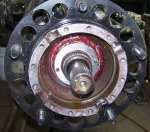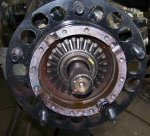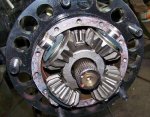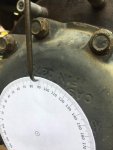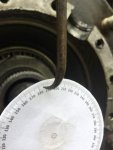- 3,024
- 230
- 63
- Location
- eldersburg maryland
OK so these are not planetary but spider gears like in the diff. Could planetary be installed in place of this whole setup? Why not?
Last edited:
Steel Soldiers now has a few new forums, read more about it at: New Munitions Forums!

The axles are a bevel gear reduction on the wheel end, not portals. Regardless of bevel gear size the reduction will always be 2:1 unless they are eliminated.does the FMTV have portal axles? Can you change the gears in the hub? I can have gears made pretty cheap.
Hi, sorry that is not always true. The ratio is that of the drive gear and the fixed gear. So the axle drives a bevel gear and there is a fixed gear on the axle housing with spider gears fixed to the hub. If the 2 gears involved are both 24 tooth like I think, it will be 2:1 reduction and turn in the same direction. I have heard other ratios but since I have not seen and counted myself I reserve comment. Further research is needed if increasing the drive gear by 1 tooth and reducing the fixed gear by 1 would be enough or maybe 2 is needed. Many things can be done, nothing is impossible.The axles are a bevel gear reduction on the wheel end, not portals. Regardless of bevel gear size the reduction will always be 2:1 unless they are eliminated.
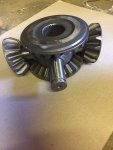 Here is a photo of the reduction gears in the hub. Reduction is due to the ratio of the spider gears to the input/output gears. To change the reduction you change the spider gear size. The top input and the bottom output gears have to be the same size or it all bindes up. Without a complete change of the hub design there is no room for larger spider gears for a higher wheel speed vs input shaft speed. With the fmtv spindle and hub combo, your stuck at 2:1 in the hub. It’s not like a true planetary where you can change the input and sun gears to change final ratio.
Here is a photo of the reduction gears in the hub. Reduction is due to the ratio of the spider gears to the input/output gears. To change the reduction you change the spider gear size. The top input and the bottom output gears have to be the same size or it all bindes up. Without a complete change of the hub design there is no room for larger spider gears for a higher wheel speed vs input shaft speed. With the fmtv spindle and hub combo, your stuck at 2:1 in the hub. It’s not like a true planetary where you can change the input and sun gears to change final ratio.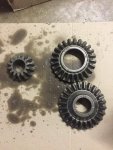 https://www.steelsoldiers.com/showthread.php?144834-M1078-LMTV-planetary-hub-setup. Has photos of it all installed
https://www.steelsoldiers.com/showthread.php?144834-M1078-LMTV-planetary-hub-setup. Has photos of it all installedAgree. The 2:1 ratio is that of 'diameter' to 'radius' and is constant. The actual diameter does not matter, nor does number of teeth. The teeth simply couple the "spider" gears to the end plates, allow them to transfer torque, and could be any size.The axles are a bevel gear reduction on the wheel end, not portals. Regardless of bevel gear size the reduction will always be 2:1 unless they are eliminated.
I should have added IMHO preceding my comments. I have been wrong before.Agree. The 2:1 ratio is that of 'diameter' to 'radius' and is constant. The actual diameter does not matter, nor does number of teeth. The teeth simply couple the "spider" gears to the end plates, allow them to transfer torque, and could be any size.
